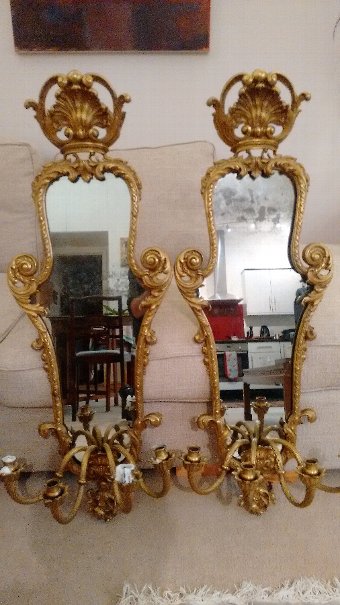antiques in pairs: mirrors
A mirror is an object that reflects an image. Light that bounces off a mirror will show an image of whatever is in front of it, when focused through the lens of the eye or a camera. Mirrors reverse the direction of the image in an equal yet opposite angle from which the light shines upon it. This allows the viewer to see themselves or objects behind them, or even objects that are at an angle from them but out of their field of view, such as around a corner. Natural mirrors have existed since prehistoric times, such as the surface of water, but people have been manufacturing mirrors out of a variety of materials for thousands of years, like stone, metals, and glass. In modern mirrors, metals like silver or aluminum are often used due to their high reflectivity, applied as a thin coating on glass because of its naturally smooth and very hard surface.
-
An elegant George III giltwood and carton-pierre oval pier glass, late 18th Century
sia antion, riga, latvia
An elegant and refined George III giltwood and carton-pierre oval pier glass, late 18th Century, with egg and dart border below a husk-swagged urn cresting, and trailing husks to the pierced foliate apron beneath. Similar designs for oval-shaped pier-glasses can be seen in a volume of designs (held at the V & A) for furniture, interior decoration, and architectural fittings, by John Linnell (1729-1796). He was the son of the famous furniture maker William Linnell (ca. 1703-1763) and gained a design education at the St. Martin`s Lane Academy founded by William Hogarth in 1735. In 1750, aged 21, John Linnell joined his father`s firm as a designer, taking over the family firm at his father’s death in 1763 going on to produce high quality furniture During his lifetime John Linnell produced high quality furniture, “which rivalled that of other leading furniture makers such as Thomas Chippendale, John Cobb and William Ince and John Mayhew.” V & A, Prints, Drawings & Paintings Collection, E.174-1929 These drawings for two oval pier-glasses in pencil, pen, and ink, were executed as sketches and were probably intended for Linnell’s personal use as preliminary designs. The urn cresting demonstrates the way in which artists and designers were using these forms within their designs during the neoclassical period in the second half of the 18th century, inspired by the discoveries of objects from sites such as Pompeii and Herculaneum According to the V & A, this design is part of a group of over 900 drawings of frames, mainly for pier glasses, overmantels, and girandoles. Many of these workshop designs share similar characteristics such as leaf scrolls and festoons of husks. Most of them are numbered, contain information about who ordered them, the date, the price (written in code), the colour of the frame and the dimensions of the finished object. Width: 58.4cm, Height: 119cm, Depth: 5cm, Weight: 10unkg, Condition: Excellent, Material: Gilding, ID: 8793
£15,348.56
view details -
Mirror in frame of Neo-rococo style. 19th century.
sia antion, riga, latvia
Luxurious mirror in the frame of Neo-rococo style, second half of the 19th century. Whimsical decor on gilded wood, cut glass. Internal dimensions 76x60 cm. Width: 94cm, Height: 106cm, Depth: 13.5cm, Weight: 20kg, Condition: Very good, Material: Wood, Plaster, Gilding, ID: 3839
£753.20
view details -
Mirror with console in Neo Rococo style. France. early 20th century.
sia antion, riga, latvia
Mirror with console made of gilded wood, decorated with decor in Neo Rococo style. White marble tabletop. Dimensions: Mirror. Height 175 cm. Width 65 cm. Console table. Width 69 cm. Depth 30 cm. Height 76 cm. Width: 69cm, Height: 251cm, Depth: 30cm, Weight: 30kg, Condition: Signs of wear commensurate with age, Material: Marble, ID: 2618
£1,255.34
view details -
Floor mirror. Jugendstil
sia antion, riga, latvia
Floor-standing mirror-console Jugendstil, early 20th century Germany. Alpha and Omega of spiritual and organic synthesis. This is exactly how this theme develops from the stylized A at the base of the console to the Omega at the top of the mirror. The shaped frame of the mirror, sprouting flowers, flows into the flanking cruciferous buds and ends with three colors in an angelic takeoff. Symbolic references to Christianity reflect the special status and role of man. He is the connecting rod of physical and spiritual beauty. He is a measure of time and a living organic embodiment of the spirit. Here in the mirror it becomes the connecting main element in the sacred primer of the universe. Width: 112cm, Height: 280cm, Depth: 32cm, Weight: 30kg, Condition: Earlier restoration, Material: Walnut, ID: 2159
£3,766.01
view details -
Rococo mirror.
sia antion, riga, latvia
Large wall mirror in the Rococo style. Carved wood, gilding. Measure and harmony define it. Neither the diagonal of the garrulous putti, nor the roccaille framing of the top and bottom violate the discreet oval of the mirror. Its smooth silhouette subordinates the decor to harmony and is full of chamber lyrics. The frame is richly decorated with rocaille elements: foliage, roses and putti holding garlands of flowers. H-135 cm. Width: 65cm, Height: 135cm, Depth: 15cm, Weight: 15kg, Condition: Earlier restoration, Material: Plaster, ID: 642
£2,092.23
view details -
Pair of Gilt Framed mirrors
bore park antiques, nuneaton, united kingdom
Top quality mirrors, excellent Gilt framing and each corner of frame adorned with semi precious stone also good quality bevelled glass too, no damage sizes are height 48 cm length 40 cm depth 2 cm,...
£595.00
view details -
Pair of French Girandoles (mirrored candelabra)
private seller, oxford, united kingdom
A pair of rare, stunning French 19th Century solid gilt brass girandole (Circa 1880), both with very nicely foxed 5mm mercury plate glass. Measuring 110cm high x 40 cm wide each with four-branch candlesticks, these...
£4,500.00
view details












